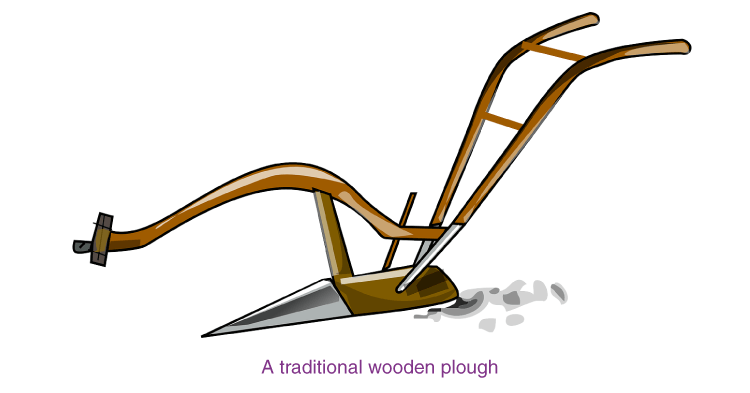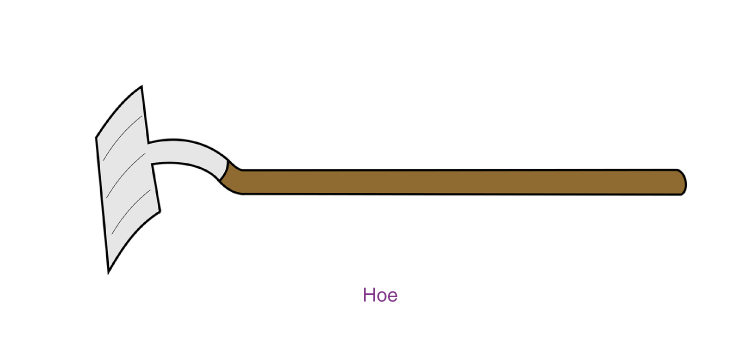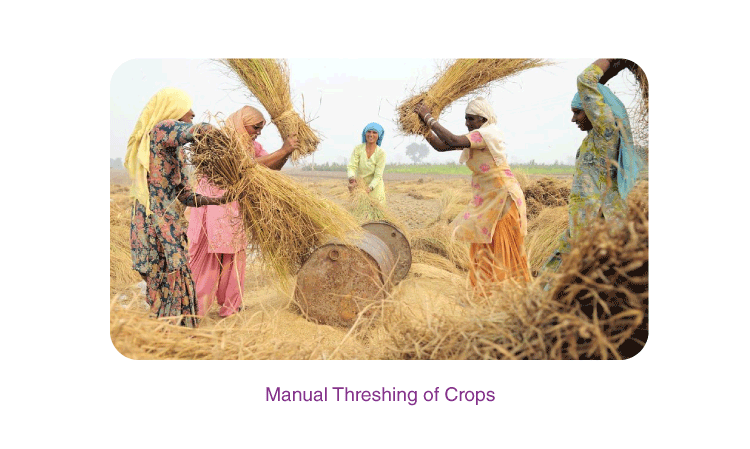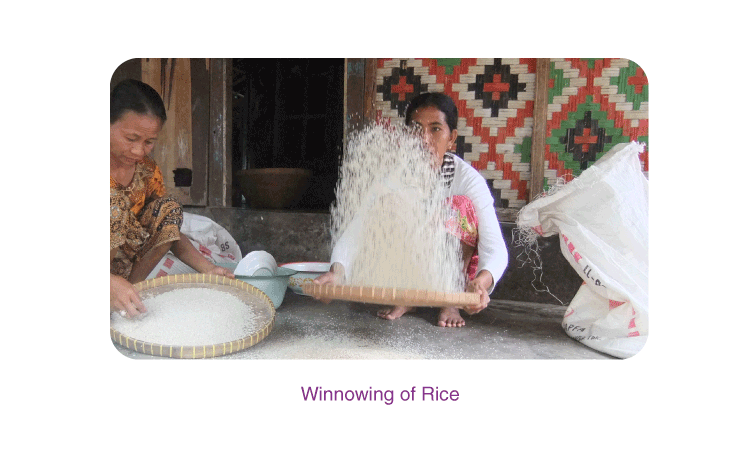Crop
Plants of the same kind that are grown and cultivated as a source of food in a large cultivable land is called a crop.
Types of Crops
Crops, which are grown in the winter season (from October to March) are called Rabi crops.
The crops, which are sown in the rainy season (from July to October) are called Kharif crops.
Preparation of Soil
- Preparation of soil is the first step in cultivating crop for food production.
- The soil is prepared for sowing the seeds of the crop.
- This is carried out using various processes and tools.
Tilling or Ploughing
The process of loosening and turning of the soil is called tilling or ploughing and is done by using a plough.
Plough
- A plough is a device that is used by farmers for different purposes such as adding of fertilizers, tilling and loosening of the soil.
- It is also used for adding fertilizers to the soil, removing weeds, scraping of soil, etc.
- The ploughshare is the triangular iron strip.
- A ploughshaft is the main part of the plough, which is made using a log of wood.
- The other end of the shaft has a handle.
- The other end is attached to a beam which is placed on the bull’s necks.
- A wooden, traditional plough can be operated by a pair of an ox and a man.
- Nowadays these wooden ploughs are being replaced by the iron ploughs.

Hoe
A hoe is a tool that used to dig up soil to remove weeds and also loosen up the soil before planting a sapling.
Cultivator
- A cultivator is attached to the tractor and helps in loosening soil.
- Cultivators are used instead of ploughs since they are faster.
Sowing
- Sowing the process of planting the seeds in the soil.
- The seeds are sowed in the soil that is loosened by a cultivator or plough.
Quality of the Seeds
- Quality of the seed is an important factor that determines the crop yield.
- Selection of good seeds is done by putting the seeds in water.
- The dead and damaged seeds become hollow and float on water whereas the good seeds sink.
Traditional Tools
- Before the advent of modern agricultural machinery, traditional tools were used by farmers.
- These include ploughs, shovels, scythes and pickaxes.
- The traditional tool used to sow the seeds was like a funnel.
- Once seeds were put into this funnel, they would go to 2-3 tubes having sharp ends.
- The ends will pierce into the soil and place the seeds there.
Seed Drill
- Seed drills are used for sowing with the help of tractors.
- It ensures that seeds are sown uniformly, at a particular depth and are covered by soil after sowing.
Nursery
- A nursery is a place where young plants and trees are grown for planting elsewhere.
- Nursery acts as a repository of saplings.
Germination of Seeds
- Germination of the seed happens when the seed is sown in the land and watered.
- A plant starts to emerge from the seed and starts to grow.
Adding Manure and Fertilisers
Manure/Fertilizers
- Manures and fertilizers are the substances that are added to the soil to increase their fertility.
- While manures are made by decomposition of organic substances, fertilizer is made of inorganic chemicals.
Differences between Manure and Fertilizers
| Fertilizer | Manure |
| Fertilizer is an inorganic salt | Manure is prepared from organic matter such as human waste, cow dung and farm waste |
| Fertilizers are manufactured in factories | Manures can be prepared in farms |
| Fertilizers are added in comparatively smaller quantities | Manures need to be added in large quantity as the nutrient content is less |
| Fertilizers do not provide any humus to the soil | Manures provide a lot of humus to soil |
Disadvantages of Using Fertilizers
- Excessive use of fertiliser can cause pollution.
- It can also change pH of the soil in certain rare cases.
Leaving the Land Fallow
- When land is left fallow for a certain period of time, the land replenishes its nutrients by itself.
- This land can be used for agriculture again.
Crop Rotation
- Crop rotation ensures that the same crop will not grow continuously and lead to the erosion of the soil fertility.
- By growing crops that require different sets of nutrient, we can ensure the soil fertility is restored.
Protecting from Weeds
Weeds
Weeds are undesirable plants that may grow naturally along with the crop.
- Weeds compete with the crops by absorbing all the water, nutrients, space and light.
Tilling
- Tilling is a process done before sowing of crops that helps in uprooting and killing of weeds.
Manual Removal
- Manual removal includes physical removal of weeds by uprooting them from the soil or chopping them off to ground level periodically.
Weedicides
- Chemicals used to kill the weeds are known as weedicides.
- They usually don’t damage the crop.
Harvesting
- Harvesting is the process of cutting the crop after it is mature.
Methods of Harvesting
- Harvesting is done by 2 methods.
- First is the manual method where a sickle is used.
- Second is the mechanical method where a huge machine called harvester is used.
Threshing
- Threshing is the process of loosening the grains from the chaff.
- While it can be done manually, these days a machine is used that separates all the grain seeds.

Winnowing
- Winnowing is the process of separation of grain seeds from the chaff using the help of the wind.
- Due to the wind, the lighter chaff flies away and the heavier grains fall down.

Storage
- Storage of the grains is an important step in agriculture.
- After harvesting steps, the ready grains are stored in granaries or silos.
- The grains have to be stored in a dry place that does not have a rodent or fungal infestation.
- Fumigation of storage places is carried out to make it free from microbes.
Granaries
- Granaries are the place where the freshly obtained food grains are stored.
Animal Husbandry
- Animal husbandry is the management and care of farm animals for milk, egg or meat.
No comments:
Post a Comment